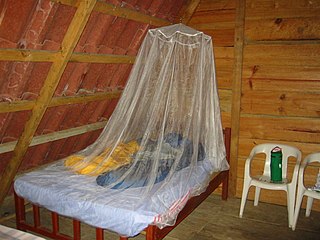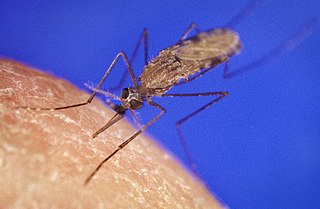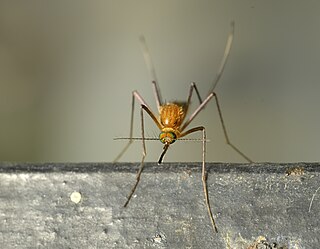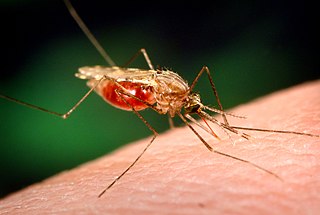
Anopheles is a genus of mosquito first described by J. W. Meigen in 1818, and are known as nail mosquitoes and marsh mosquitoes. Many such mosquitoes are vectors of the parasite Plasmodium, a genus of protozoans that cause malaria in birds, reptiles, and mammals, including humans. The Anopheles gambiae mosquito is the best-known species of marsh mosquito that transmits the Plasmodium falciparum, which is a malarial parasite deadly to human beings; no other mosquito genus is a vector of human malaria.

Plasmodium falciparum is a unicellular protozoan parasite of humans, and the deadliest species of Plasmodium that causes malaria in humans. The parasite is transmitted through the bite of a female Anopheles mosquito and causes the disease's most dangerous form, falciparum malaria. It is responsible for around 50% of all malaria cases. P. falciparum is therefore regarded as the deadliest parasite in humans. It is also associated with the development of blood cancer and is classified as a Group 2A (probable) carcinogen.

A mosquito net is a type of meshed curtain that is circumferentially draped over a bed or a sleeping area, to offer the sleeper barrier protection against bites and stings from mosquitos, flies, and other pest insects, and thus against the diseases they may carry. Examples of such preventable insect-borne diseases include malaria, dengue fever, yellow fever, zika virus, Chagas disease and various forms of encephalitis, including the West Nile virus.

The Anopheles gambiae complex consists of at least seven morphologically indistinguishable species of mosquitoes in the genus Anopheles. The complex was recognised in the 1960s and includes the most important vectors of malaria in sub-Saharan Africa, particularly of the most dangerous malaria parasite, Plasmodium falciparum. It is one of the most efficient malaria vectors known. The An. gambiae mosquito additionally transmits Wuchereria bancrofti which causes lymphatic filariasis, a symptom of which is elephantiasis.

Anopheles dirus is a vector of malaria in Asian forested zones.
Anopheles (Cellia) subpictus is a species complex of four species of mosquito belonging to the genus Anopheles.
Rajpal Singh Yadav is an Indian scientist in the field of vector ecology and management. He joined the World Health Organization in 2009. He retired in 2023, as a Scientist at the Department of Control of Neglected Tropical Diseases, Geneva, Switzerland. He was a Co-Chair of the WHO Joint Action Group for the implementation of the Global Vector Control Response,. He was also Head of the WHO Pesticide Evaluation Scheme (WHOPES) for the evaluation of vector control products. During this period he reviewed research protocols and generated a global evidence base for insecticide use and pesticide management. He was also a Focal person in, the WHO secretariat for the FAO/WHO Joint Programme on Pesticide Management. The work involved collaboration with other UN and international organizations, research institutions, programmes, industry, NGOs, and other stakeholders. He is the recipient of the 2016, Lifetime Achievement Award from the Indian Association of Entomologists. He has published more than 100 scientific articles in peer-reviewed journals.

Anopheles albimanus is a species of mosquito in the order Diptera. It is found in coastal Central and South America, the Caribbean, and Mexico. It is a generalist species and capable of wide dispersion. A. albimanus is a common malaria vector.

Anopheles stephensi is a primary mosquito vector of malaria in urban India and is included in the same subgenus as Anopheles gambiae, the primary malaria vector in Africa. A. gambiae consists of a complex of morphologically identical species of mosquitoes, along with all other major malaria vectors; however, A. stephensi has not yet been included in any of these complexes. Nevertheless, two races of A. stephensi exist based on differences in egg dimensions and the number of ridges on the eggs; A. s. stephensisensu stricto, the type form, is a competent malaria vector that takes place in urban areas, and A. s. mysorensis, the variety form, exists in rural areas and exhibits considerable zoophilic behaviour, making it a poor malaria vector. However, A. s. mysorensis is a detrimental vector in Iran. An intermediate form also exists in rural communities and peri-urban areas, though its vector status is unknown. About 12% of malaria cases in India are due to A. stephensi.

Anopheles darlingi, the American malaria mosquito, is a species of mosquito in the family Culicidae. A. darlingi is one of the major species of mosquito known to be responsible for malaria in the Amazonian regions. It has a wide range of geographic distribution that stretches from Mexico and Argentina but it has also been found to populate in areas affected by deforestation and environment changes due to humans.

Attractive toxic sugar baits (ATSBs) are oral insecticides designed to reduce malaria infections by killing the host vector – the mosquito – rather than the parasite itself.

Anopheles sinensis is a species of mosquito that transmits malaria as well as lymphatic filariasis. It is regarded as the most important vector of these human parasitic diseases in Southeast Asia. It is the primary vector of vivax malaria in many regions. In China it also transmits the filalarial parasite, and arthropod roundworm. In Japan it is also a vector of a roundworm Setaria digitata in sheep and goats.
Anopheles nili is a species of mosquito in the Culicidae family. It comprises the following elements: An. carnevalei, An. nili, An. ovengensis and An. somalicus. The scientific name of this species was first published in 1904 by Theobald. It is the main mosquito species found in the south Cameroon forest zone which bites humans. It is known as a problematic carrier of malaria, although newly discovered, closely related species in the same genus have also been found to interact with A. nili as a disease vector. In that, they both have similar feeding habits on local targets in the Cameroon region.

Plasmodium cynomolgi is an apicomplexan parasite that infects mosquitoes and Asian Old World monkeys. In recent years, a number of natural infections of humans have also been documented. This species has been used as a model for human Plasmodium vivax because Plasmodium cynomolgi shares the same life cycle and some important biological features with P. vivax.
Anopheles (Cellia) vagus is a species complex of zoophilic mosquito belonging to the genus Anopheles. It is found in India, Sri Lanka and Indonesia. It is a potential natural vector of malarial parasite Plasmodium falciparum, and Japanese encephalitis virus. It is highly susceptible to insecticide deltamethrin and resistant to DDT.

Coquillettidia (Coquillettidia) crassipes is a species complex of zoophilic mosquito belonging to the genus Coquillettidia.

Airport malaria, sometimes known as baggage, luggage or suitcasemalaria, occurs when a malaria infected female Anopheles mosquito travels by aircraft from a country where malaria is common, arrives in a country where malaria is usually not found, and bites a person at or around the vicinity of the airport, or if the climate is suitable, travels in luggage and bites a person further away. The infected person usually presents with a fever in the absence of a recent travel history. There is often no suspicion of malaria, resulting in a delay in diagnosis. It is typically considered as a diagnosis after other explanations for symptoms have been ruled out.

Quartan fever is one of the four types of malaria which can be contracted by humans.

Anopheles funestus is a species of mosquito in the Culicidae family. This species was first described in 1900 by Giles. The female is attracted to houses where it seeks out humans in order to feed on their blood, mostly during the night. This mosquito is a major vector of malaria in sub-Saharan Africa.
The 1906 malaria outbreak in Ceylon, was a major malaria outbreak in Ceylon during the early twentieth century. The first cases were reported in the early 1900s but not officially recorded until 1906. Malaria has been prevalent on the island since the 3rd century B.C. Malaria is caused by single-cell microorganisms of Plasmodium group. This disease is commonly spread by the female Anopheles mosquito. Most Anopheles mosquito species are native in Sri Lanka. There are four main mosquito species on the island including: Anopheles culicifacies, Anopheles subpictus, Anopheles annularis and Anopheles varuna.












